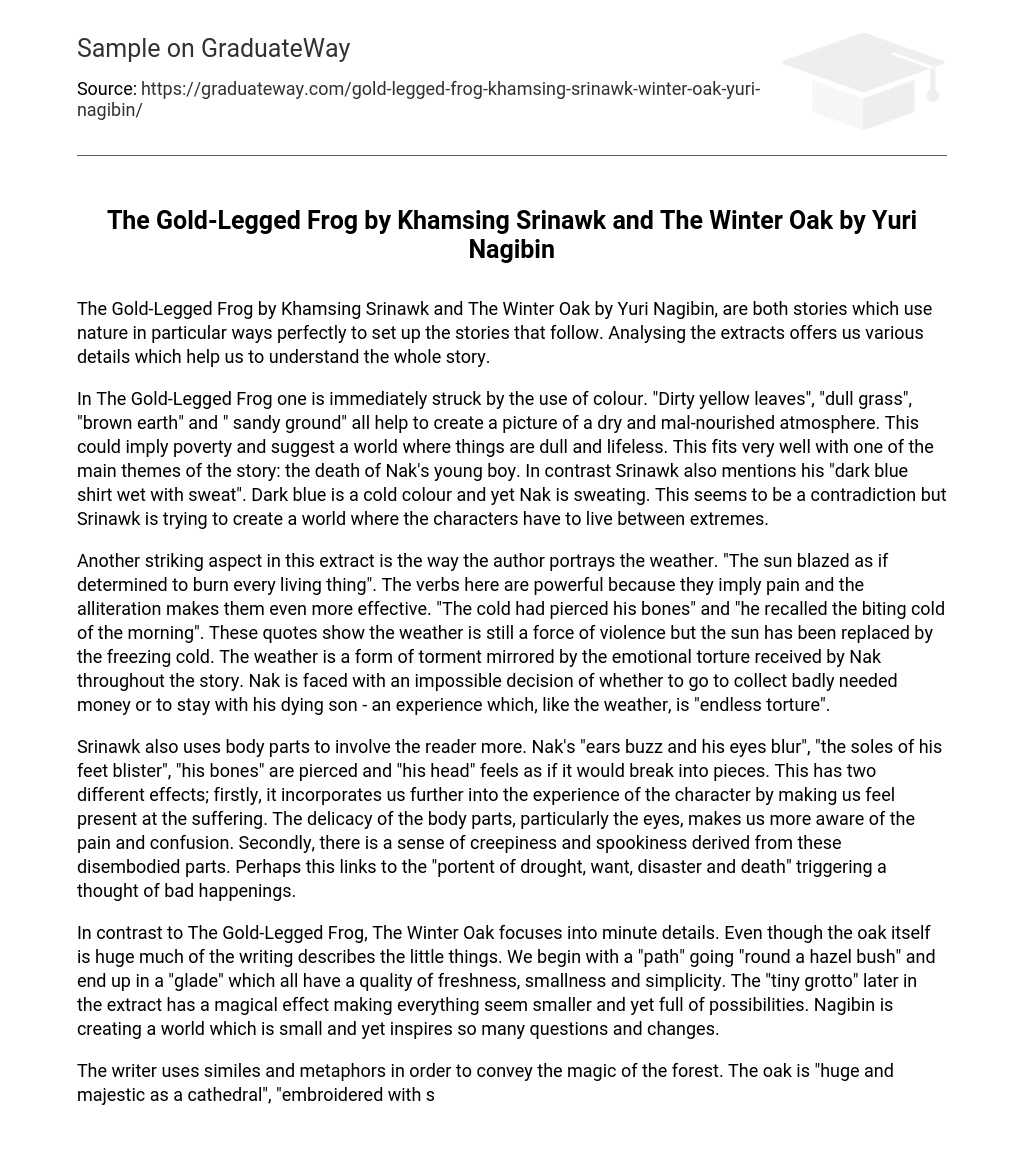The Gold-Legged Frog and The Winter Oak, are both stories which use nature in particular ways perfectly to set up the stories that follow. Analysing the extracts offers us various details which help us to understand the whole story.
In The Gold-Legged Frog one is immediately struck by the use of colour. “Dirty yellow leaves”, “dull grass”, “brown earth” and ” sandy ground” all help to create a picture of a dry and mal-nourished atmosphere. This could imply poverty and suggest a world where things are dull and lifeless. This fits very well with one of the main themes of the story: the death of Nak’s young boy. In contrast Srinawk also mentions his “dark blue shirt wet with sweat”. Dark blue is a cold colour and yet Nak is sweating. This seems to be a contradiction but Srinawk is trying to create a world where the characters have to live between extremes.
Another striking aspect in this extract is the way the author portrays the weather. “The sun blazed as if determined to burn every living thing”. The verbs here are powerful because they imply pain and the alliteration makes them even more effective. “The cold had pierced his bones” and “he recalled the biting cold of the morning”. These quotes show the weather is still a force of violence but the sun has been replaced by the freezing cold. The weather is a form of torment mirrored by the emotional torture received by Nak throughout the story. Nak is faced with an impossible decision of whether to go to collect badly needed money or to stay with his dying son – an experience which, like the weather, is “endless torture”.
Srinawk also uses body parts to involve the reader more. Nak’s “ears buzz and his eyes blur”, “the soles of his feet blister”, “his bones” are pierced and “his head” feels as if it would break into pieces. This has two different effects; firstly, it incorporates us further into the experience of the character by making us feel present at the suffering. The delicacy of the body parts, particularly the eyes, makes us more aware of the pain and confusion. Secondly, there is a sense of creepiness and spookiness derived from these disembodied parts. Perhaps this links to the “portent of drought, want, disaster and death” triggering a thought of bad happenings.
In contrast to The Gold-Legged Frog, The Winter Oak focuses into minute details. Even though the oak itself is huge much of the writing describes the little things. We begin with a “path” going “round a hazel bush” and end up in a “glade” which all have a quality of freshness, smallness and simplicity. The “tiny grotto” later in the extract has a magical effect making everything seem smaller and yet full of possibilities. Nagibin is creating a world which is small and yet inspires so many questions and changes.
The writer uses similes and metaphors in order to convey the magic of the forest. The oak is “huge and majestic as a cathedral”, “embroidered with silver thread” and “the mighty, magnanimous guardian of the forest quietly waved a branch in greeting to her”. Simile and metaphor are both devices which are not literal and require imagination and creativity. This is one of the major themes of the story. Savushkin is a young boy with deep imagination and a rich train of thought who ends up teaching his teacher many valuable lessons.
In this extract we see how the main character and nature work together. We also see how the oak works to protect the rest of the forest, “the lower branches spread out over the glade like a canopy”. In a co-operative exchange the rest of the forest repays the oak – the trees “respectfully stood aside to give their older brother room to display himself in all his strength”. The verbs are much gentler in this extract; for example, leaves are “encased in snow”. Savushkin is also gentle with the animals, he “carefully covered the hedgehog up” and touches the frog lightly.
As contradictory as these two extracts are, there are some points which run in parallel. The Gold-Legged Frog is a more brutal story, involving killing frogs in order to stay alive whereas in The Winter Oak there is a lot more love of humans towards animals. Savushkin’s frog is “pretending to be dead” but will be hopping about once it has been warmed by the sun.
In contrast, the sun in the first extract is painful, burning and killing. The sun here is victimising the main character whereas in the second extract the boy is in control of his own small world. The oak is superior but not in a threatening way and Savushkin approaches it “as if approaching an old acquaintance”. On the other hand, Nak has no control over his surroundings and gains no comfort from the natural world. To add to his powerlessness he is at the mercy of the officials who force him to leave his dying child in order to keep himself out of jail. Perhaps the cruelty of the natural world mirrors this injustice.
The writers use grammatical devices in different ways to portray natural worlds that perfectly fit the action of the stories that take place in them.





